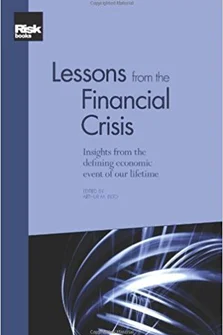The Re-Emergence of Distressed Exchanges in Corporate Restructurings
Edward I Altman and Brenda Karlin
Introduction to 'Lessons from the Financial Crisis'
The Credit Crunch of 2007: What Went Wrong? Why? What Lessons Can be Learned?
Underwriting versus Economy: A New Approach to Decomposing Mortgage Losses
The Shadow Banking System and Hyman Minsky’s Economic Journey
The Collapse of the Icelandic Banking System
The Quant Crunch Experience and the Future of Quantitative Investing
No Margin for Error: The Impact of the Credit Crisis on Derivatives Markets
The Re-Emergence of Distressed Exchanges in Corporate Restructurings
Modelling Systemic and Sovereign Risks
Measuring and Managing Risk in Innovative Financial Instruments
Forecasting Extreme Risk of Equity Portfolios with Fundamental Factors
Limits of Implied Credit Correlation Metrics Before and During the Crisis
Another view on the pricing of MBSs, CMOs and CDOs of ABS
Pricing of Credit Derivatives with and without Counterparty and Collateral Adjustments
A Practical Guide to Monte Carlo CVA
The Endogenous Dynamics of Markets: Price Impact, Feedback Loops and Instabilities
Market Panics: Correlation Dynamics, Dispersion and Tails
Financial Complexity and Systemic Stability in Trading Markets
The Martingale Theory of Bubbles: Implications for the Valuation of Derivatives and Detecting Bubbles
Managing through a Crisis: Practical Insights and Lessons Learned for Quantitatively Managed Equity Portfolios
Active Risk Management: A Credit Investor’s Perspective
Investment Strategy Returns: Volatility, Asymmetry, Fat Tails and the Nature of Alpha
In 2008 and 2009, bondholders of ailing companies were affected by a re-emergence of an important corporate restructuring strategy, known as a “distressed exchange” (DE). This tactic is usually an attempt by an ailing firm to avoid bankruptcy by proposing a fundamental change in the contractual relationship between a debtor and its various creditor classes and is “voluntarily” agreed upon by a sufficient percentage (usually 90% or more) of relevant creditor claims. While one of the most common and dramatic DEs involves a substitution of lower priority equity securities for debt claims, DEs can also result from a reduction of the effective interest rate on the debt, a subordination of claims, an extension of time to repay the debt or a package of new securities, cash and other securities, that have a total value that is less than the face value of the original debt claim. Another critical component is the condition that the original claim is selling at a distressed price at the time of the DE announcement, usually below 70 cents on the US dollar. The resulting situation is still called a DE even if the price of the existing debt increases after the announcement. The recovery rate to
Copyright Infopro Digital Limited. All rights reserved.
As outlined in our terms and conditions, https://www.infopro-digital.com/terms-and-conditions/subscriptions/ (point 2.4), printing is limited to a single copy.
If you would like to purchase additional rights please email info@risk.net
Copyright Infopro Digital Limited. All rights reserved.
You may share this content using our article tools. As outlined in our terms and conditions, https://www.infopro-digital.com/terms-and-conditions/subscriptions/ (clause 2.4), an Authorised User may only make one copy of the materials for their own personal use. You must also comply with the restrictions in clause 2.5.
If you would like to purchase additional rights please email info@risk.net










